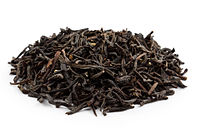
Photo from wikipedia
Volatile flavor compounds in 112 black teas from seven countries were analyzed by untargeted metabolomics using headspace solid-phase microextraction and gas chromatography-mass spectrometry (HS-SPME/GC-MS). Multivariate statistical analysis and odor activity… Click to show full abstract
Volatile flavor compounds in 112 black teas from seven countries were analyzed by untargeted metabolomics using headspace solid-phase microextraction and gas chromatography-mass spectrometry (HS-SPME/GC-MS). Multivariate statistical analysis and odor activity values (OAVs) were used to classify these samples and identify key odorants. A total of 140 volatile flavor compounds (VFCs), including 12 different groups, were identified, and alcohols were prevalent in China and India samples, accounting for 40.83% and 34.96% of the total VFCs, respectively. Eight volatile compounds with OAVs > 1 were identified as key active differential odorants in Chinese, Indian, and Sri Lankan samples, including linalool, pentanoic acid, methyl salicylate, hexanoic acid, 1-methyl-naphthalene, phenylethyl alcohol, geraniol, and β-ionone. Linalool, pentanoic acid, and hexanoic acid in Indian black teas, phenylethyl alcohol in Chinese black teas, and 1-methyl-naphthalene, β-ionone in Sri Lankan black teas could be used to discriminate different black tea groups. A total of 12-14 VFCs with OAVs > 1 were identified as key active aromatics in Chinese black tea sample. Linalool and benzeneacetaldehyde in Yingde (Guangdong) black tea, methyl salicylate in Taiwanese samples, and benzeneacetic acid in Anhui black tea could be used as biomarkers to distinguish them from other Chinese samples. Sensory evaluation results showed that most black teas presented the common sweet, floral odors, which were consistent with GC-MS analysis. These results will contribute to characterize the odor metabolome of black teas and provide biochemical basis for identifying the authenticity of different black teas. PRACTICAL APPLICATION: Linalool, pentanoic acid, and hexanoic acid in Indian black teas, phenylethyl alcohol in Chinese black teas, 1-methyl-naphthalene, β-ionone, and methyl salicylate in Sri Lankan black teas could be used to discriminate black teas from the three countries. Linalool and benzeneacetaldehyde in Yingde black teas, methyl salicylate in Taiwanese black teas, and benzeneacetic acid in Anhui black tea are the potential biomarkers to distinguish these teas from other Chinese black teas.
Journal Title: Journal of food science
Year Published: 2022
Link to full text (if available)
Share on Social Media: Sign Up to like & get
recommendations!